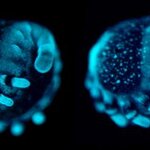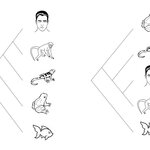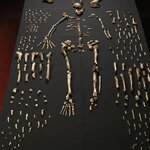Evolution

Human brains exhibit more plasticity, the tendency to be modeled by the environment, than chimpanzee brains, which may account for part of human evolution, according to a study which may provide insight into why humans are capable of adapting to various environments and cultures. The stud examined the inherited genetic factors of brain organization in humans compared to their closest living relatives.
The research team studied 218 human brains and 206 chimpanzee brains to compare two things: brain size and organization as related to genetic similarity. The study found that human and…

Living hominoids are a group of primates that includes the small-bodied apes (the lesser apes, or gibbons and siamangs, which constitute the family Hylobatidae) and the larger-bodied great apes (orangutans, gorillas and chimpanzees), which, along with humans, belong to the family Hominidae.
All extant hominoids share several features, such as the lack of external tail, an orthograde body plan that enables an upright trunk position, and several cranial characteristics. All these features might have been present in the common ancestor of hominids and hylobatids that, according to molecular…

A team of paleontologists find in a new fossil study that the extraordinary regenerative capacities of modern salamanders are likely an ancient feature of four-legged vertebrates that was subsequently lost in the course of evolution.
Salamanders are extraordinary among modern four-legged vertebrates in showing an astonishing capacity to regenerate limbs, tails, and internal organs that were injured or lost due to amputation repeatedly and throughout their entire lifespan.
The mechanisms controlling this high regenerative capacity are the focus of a large field of research driven by the hope…

An evolutionary puzzle in the genome of several different snake species is why their genetic code has DNA that, in most animals, controls the development and growth of limbs. Since snakes have long, legless bodies that such genetic code was likely to have disappeared during evolution but a new study .
Now, they've found an explanation. In a paper the scientists show that the same genetic tools responsible for limb development also control the formation of external genitalia, and that may help explain why snakes have held on to this limb circuitry through the ages.
Snakes weren't always…

In a new study, Nikola-Michael Prpic et al. have identified the driving force behind the evolution of a leg novelty first found in spiders: knees.
With eight hairy legs and seven joints on each---that's a lot of joints for a spider to coordinate in order to take even a single step. To find some answers, Prpic's research team honed in on a gene called dachshund (dac). The gene was first discovered in fruit flies, and the discoverers named the missing leg segments and shortened legs that result from dac mutant flies after the short-legged dog breed of the same name.
What is…

This spring, the world learned of a newly discovered missing link between microbes and humans called Lokiarchaeota. The actual story is that the microbe Lokiarchaeota, discovered on the deep sea floor by a hydrothermal vent called Loki’s Castle, shares features with both bacteria and us. The spin is that this makes it a missing link between the two.
Microbiologists have been discreetly quiet about this narrative fiction; although the microbe is fascinating, and so deserves the spotlight, it is no more a missing link than the platypus is a missing link between ducks and humans.
This missing…

Researchers ave shown that well-developed eyes come at a surprising cost to other organ systems.
Researchers have long associated the presence of a well-developed brain with major energy consumption. This means that animals that develop advanced nervous systems require environments where this is possible. There has to be good access to nutrients, and every investment in an organ comes at a cost to some other organ system that is less essential in that particular environment. Up to now, there have been few concrete measurements of how high the cost of a nervous system actually is.
The…

Working in a cave complex deep beneath South Africa's Malmani dolomites, an international team of scientists has brought to light an unprecedented trove of hominin fossils -- more than 1,500 well-preserved bones and teeth -- representing the largest, most complete set of such remains found to date in Africa.
The discovery of the fossils, cached in a barely accessible chamber in a subterranean labyrinth not far from Johannesburg, adds a new branch to the human family tree, a creature dubbed Homo naledi.
The remains, scientists believe, could only have been deliberately placed in the cave.
So…

An international team of researchers has sequenced the first complete genome of an Iberian farmer, which is also the first ancient genome from the entire Mediterranean area. This new genome allows to know the distinctive genetic changes of Neolithic migration in Southern Europe which led to the abandonment of the hunter-gatherer way of life.
The study is led by the Institute of Evolutionary Biology, a joint center of the Spanish National Research Council (CSIC) and the Universitat Pompeu Fabra (Barcelona, Spain), in collaboration with the Centre for GeoGenetics in Denmark. The results are…

Research into 430,000-year-old fossils collected in northern Spain found that the evolution of the human body's size and shape has gone through four main stages, according to a recent paper.
A large international research team including Binghamton University anthropologist Rolf Quam studied the body size and shape in the human fossil collection from the site of the Sima de los Huesos in the Sierra de Atapuerca in northern Spain.
Dated to around 430,000 years ago, this site preserves the largest collection of human fossils found to date anywhere in the world. The researchers found that…